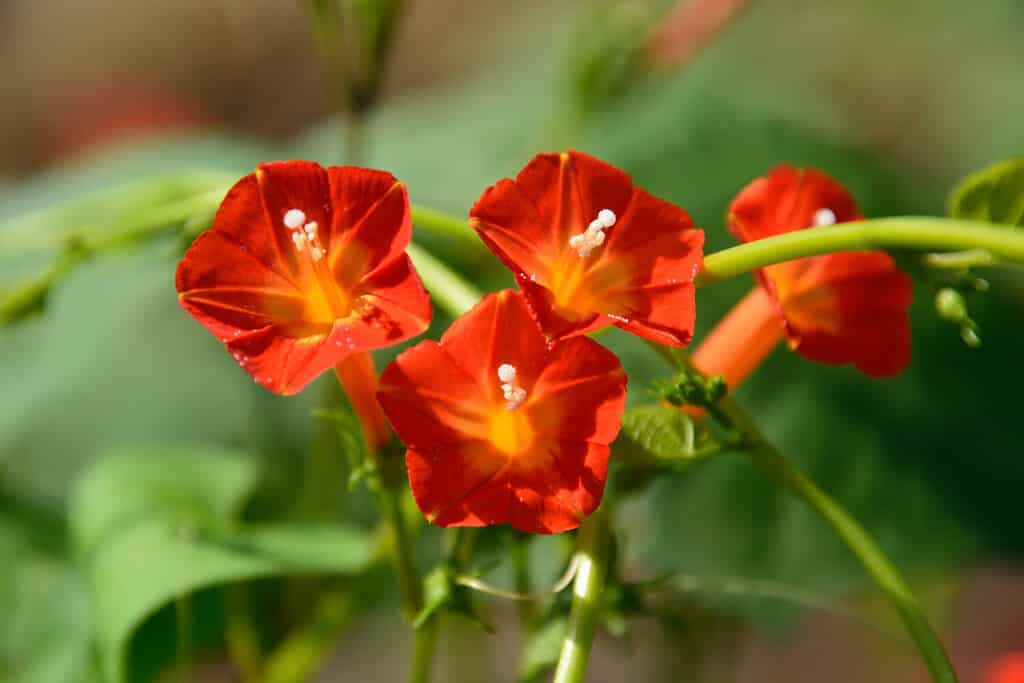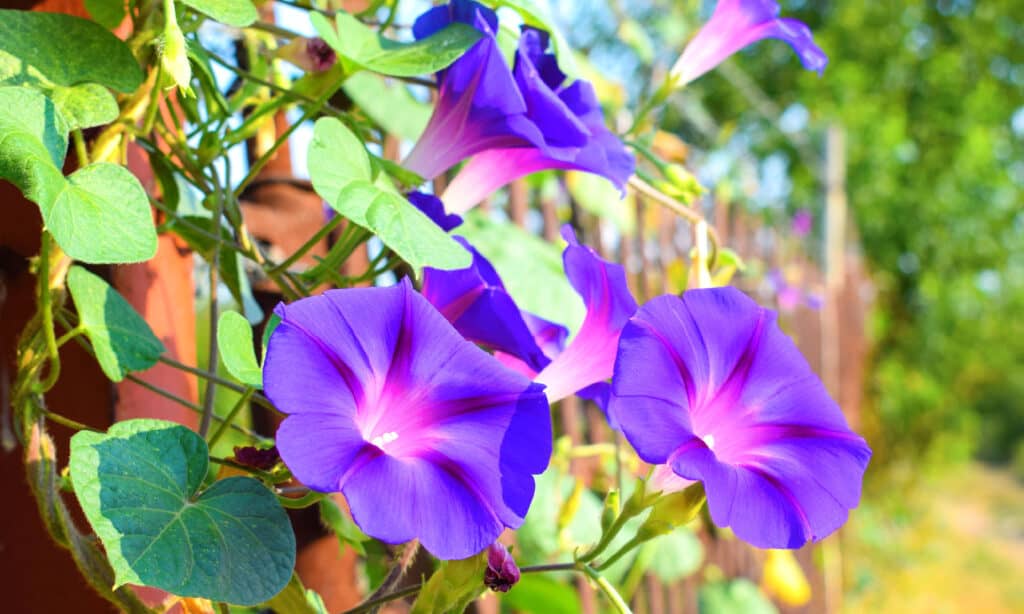The morning glory is a dynamic flowering vine that produces trumpet-shaped blooms and heart-shaped leaves. This pretty perennial is prized for its colorful blue, purple, pink, red, or white flowers. In addition, morning glories thrive in a wide range of Hardiness Zones. But when do morning glories bloom? The peak season for morning glory flowers is mid to late summer through early fall.
Let’s look at when morning glories bloom by USDA Hardiness Zone and where they may grow as annuals vs. perennials. Plus, we’ll discuss how to extend morning glory blooms and figure out why your vines might not bloom as desired.

The peak months for morning glory blooms are June through September, depending on the plant variety.
©High Mountain/Shutterstock.com
Morning Glory Peak Season by Zone
The morning glory (Ipomoea purpurea) is a fast-growing vine that could climb up to 10 feet tall and 6 feet wide in just one season! In fact, it’s such a quickly-spreading plant that morning glories can easily become invasive.
Fun Fact: The morning glory’s common name comes from the fact that its flowers open in the morning and close for good by late afternoon.
Start by Knowing Your Zone
Do you know when morning glories and other flowers bloom in your climate? If not, start by learning which USDA Hardiness Zone you live in. The USDA offers a Hardiness Zones map that breaks the country into regions with the same lowest average winter temperatures.
For example, suppose you live in Zone 5b. In that case, the average coldest temperature in 5b ranges from -15 to -10 degrees Fahrenheit. However, a Zone’s average minimum temperatures can change as years pass and weather patterns change. A 5b Zone today could have been a 4b Zone in the late 1990s, which happens to be the case for cities like Omaha, Nebraska.
Morning Glories in Your Zone
Take a quick scroll through the table below to find your Hardiness Zone, morning glory peak season, and whether your established plants will grow again next year (perennials).
If morning glories are perennials in your Zone, they will come back year after year. Though, for many Zones, morning glory plants will need to grow as annuals (one season) instead.
| USDA Hardiness Zones | Morning Glory Peak Season | Perennial or Annual? |
|---|---|---|
| Zones 2a-2b | Summer to Fall | Annual |
| Zones 3a-3b | Summer to Fall | Annual |
| Zones 4a-4b | Summer to Fall | Annual |
| Zones 5a-5b | Summer to Fall | Annual |
| Zones 6a-6b | Summer to Fall | Annual |
| Zones 7a-7b | Summer to Fall | Annual |
| Zones 8a-8b | Summer to Fall | Annual |
| Zones 9a-9b | Summer to Fall | Perennial |
| Zones 10a-10b | Summer to Fall | Perennial |
| Zones 11a-11b | Summer to Fall | Perennial |

Each morning glory flower blooms for only one day.
©Hemerocallis/Shutterstock.com
Why didn’t my morning glories bloom?
Your morning glory vines aren’t blooming, and you can’t figure out why. This phase frustrates any flower fan, especially when you give your plants lots of TLC. Not only would you miss out on this plant’s flowering beauty, but the flowers of these vines attract hummingbirds too.
Keep reading for some common reasons why morning glories don’t bloom or produce many flowers, plus easy steps to fix these issues.
Soil is Too Nutrient-rich
One of the reasons morning glories grow so quickly and become invasive is that they can thrive in low-quality soil. So, if their soil is too rich, these vines might suffer.
For example, suppose you amend their soil with fertilizer and various extra nutrients that other plants need. In that case, morning glory plants might not bloom. Crazy, right? Well, it’s true!
The main nutrient that can stunt morning glory flower production is nitrogen.
You can tell a morning glory has nitrogen-heavy soil if the plant does the following:
- Grows lush green foliage but doesn’t produce blooms
- It gets bigger but also weaker
- Develops unhealthy or stunted roots
How do you amend soil that has too much nitrogen?
- Add more mulch to absorb the extra nitrogen.
- Leach the soil with deep watering to flush out excess nutrients.
- Add organic matter to the soil to balance out the excess nitrogen.
- Grow nitrogen-loving companion plants, like cabbage, next to your morning glory vines. Beautiful cabbage leaves growing close to the ground would also add low-level garden interest to an area with morning glory vines blooming from above.
Not Enough Sunlight
You may need to transplant your morning glory vine to a place where it can get 6–8 hours of daily sunshine. Plants that don’t get adequate sun won’t provide as many of the funnel-shaped flowers that make this vine divine.
Not Enough Water
If your morning glory plants lack sufficient water, they’re in survival mode and won’t waste precious energy on producing flowers. Morning glories need an average of 1 inch of water per week, including water they might receive from rain. Hotter days (and hotter climates) may require more.
Self-Seeded Plants
Morning glory varieties you buy from professional growers are bred for magnificent and plentiful blooms. However, morning glories are self-seeding dynamos that create new plants without guaranteeing high flower production. In addition, self-seeded plants tend to produce fewer blooms per season.

Mature morning glory vines produce more blooms in soil with low nitrogen content.
©jirasak_kaewtongsorn/Shutterstock.com
How To Make Morning Glory Blooms Last Longer
Don’t blink, or you might miss seeing your morning glories bloom! Unfortunately, morning glory flowers usually last only one day. They open in the morning, then take a bow and close up shop before nightfall. However, healthy morning glories will keep on producing more one-day flowers if you take great care of these plants.
To keep your morning glory vines in tip-top shape for loads of blooms, try these easy plant care tips:
- Grow morning glories in sunny areas. They need a lot of sunlight to make more flowers. A good indication that your morning glory plant needs more sun is yellowing leaves.
- Check your plants for common diseases like rust. In addition to being a sign of low sunlight, yellowing leaves could indicate a disease called rust. Plants with rust will also develop dark spots on the leaf tops. Also, if you flip the leaves over, you might find white pustules from powdery spores.
- Provide plants with a structure to climb, like a fence, trellis, or pergola. This structure helps give the plant and its blooms more support. It also enables you to direct the growth where you want it to go.
- Deadhead the plants daily (remove spent blooms) so they will keep redirecting their energy to produce more flowers. Consistently removing the dead flowers is also important to keep the plants from self-seeding. The dead flowers turn into seed-bearing berries. Also note that morning glory seeds are toxic if ingested.
- Examine your plants for common pests like aphids and spider mites. Most pests eat morning glory leaves and stems, but a pest-infested plant might soon die and therefore stop producing blooms.
- Mulch around the plants with nitrogen-absorbing organic matter. Morning glories that absorb too much nitrogen from the soil won’t bloom.

Providing morning glory plants with a structure to climb, like a fence, trellis, or pergola helps to give the plant and its blooms more support.
©iStock.com/Wakhron
Short-lived morning glory blooms are worth the work!
Daily deadheading and keeping the plants from becoming invasive might seem like extra work for blooms that only last a day. But seeing a morning glory vine covered in colorful funnel-shaped blooms is worth the extra effort. Though each flower only lives between your morning coffee and afternoon slump, there will be many more to come. Take amazing care of these vines and enjoy their vibrant trumpet flowers from summer until autumn gets frosty.
The photo featured at the top of this post is © CoinUp/Shutterstock.com
Thank you for reading! Have some feedback for us? Contact the AZ Animals editorial team.






